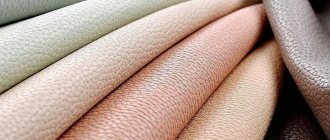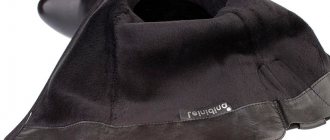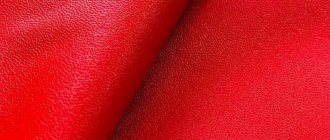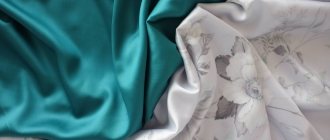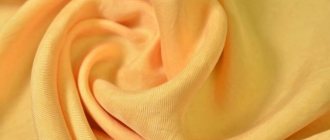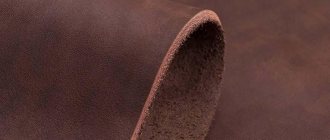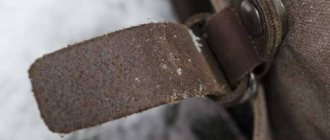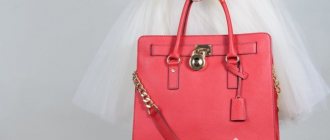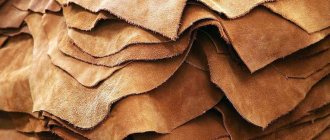Leather furniture in the interior always indicates the high status of the owner and his impeccable taste. It looks really stylish and will delight you for many years. However, despite all the positive aspects, products made from genuine leather are expensive, and not everyone can afford it.
Today on the furniture upholstery market there is a cheaper, but no less high-quality analogue - eco-leather. Cost is one of the main differences between leather and eco-leather. In the range of available products, you can choose eco-leather for furniture, the appearance and performance properties of which are no worse than natural material. Professionals cannot always distinguish soft leatherette to the touch.
What is the difference between eco-leather and leatherette
It should be noted right away that traditional leatherette and eco-leather are completely different materials in composition. Faux leather or vinyl artificial leather is a fairly thick layer of PVC base. It is known that, due to its physical properties, polyvinyl chloride has hardness and high density. To soften bags, shoes and clothes that are made from such material, special technologies are used, that is, plasticizer additives are added to the material, the percentage of which can be up to 60%, and sometimes more. In turn, eco-leather has no more than 20% base, which, as already mentioned, itself is much more soft, ductile and elastic. Let us add that polyurethane itself does not require the addition of plasticizers, since all performance qualities are already inherent in the structure of the polymer itself.
It is for this reason that school bags and children's backpacks made of eco-leather do not crack even after prolonged wear, which cannot be said about similar models made of ordinary leatherette.
Polaris Pro
The canvas has a thickness of 1.1 mm, with a density of 700 g/sq. m. Abrasion resistance at the level of 100,000 thousand cycles. Does not burn. The Polaris Pro material is used both in the automotive sector and in the water, railway, and aviation industries.
The material is not afraid of prolonged exposure to bright sunlight and is moisture resistant. It is actively used for upholstery of car interiors of all classes - from economical small cars to SUVs.
If you want to explore the line of materials from this company, visit the website https://ecokoja.ru/. There are many different models presented there, with different properties, colors, reliefs.
Advantages of bags and backpacks made of eco-leather
The advantages listed above quickly made eco-leather one of the leaders in the industry of materials for the manufacture of haberdashery and footwear. Here are just a few of the benefits of children's backpacks and school bags from Grizzly and other brands made from this material.
- Complete absence of harmful additives - children's accessories made from eco-leather are hypoallergenic and absolutely safe for humans and the environment.
- Without exaggeration, unique wear resistance. The cotton or polyester based material does not wear out even with daily use for several years.
- Externally, eco-leather almost completely imitates genuine leather (including, such bags and backpacks have the texture of genuine leather).
- In terms of properties such as thermal conductivity, eco-leather is closest to natural wood. That is why the material is increasingly used for sewing shoes and outerwear.
- Unlike many other natural and synthetic materials, eco-leather is practically not exposed to direct ultraviolet rays.
- Another undoubted advantage is the decorative properties and the ability to paint the material in almost any color. Of course, with genuine leather such possibilities are very limited.
- The most important property of eco-leather products is the ability to easily withstand severe frosts (down to -30 degrees and below). At the same time, such bags do not crack, as usually happens in the cold with haberdashery made from traditional hard and even more or less soft leatherette.
You can also mention that products made from this material do not require special care (an eco-leather bag is easy to clean with ordinary water or soap solution). It should be borne in mind that cuts and tears on the surface of eco-leather are practically impossible to repair with the help of special “leather” glue and impregnations - perhaps this is the only significant disadvantage of the material.
Areas of use
This analogue of leather is widely used to create clothing, shoes, and furniture upholstery. The combination of a presentable appearance, budget cost and ease of care are undoubtedly advantages of shoes and other leatherette products. However, there are some disadvantages: the material is prone to drying out and is flammable.
Eco-leather is used to produce the following items:
- jackets, leggings, skirts, shorts, coats, jackets;
- car covers;
- shoes - from sandals to rough boots;
- furniture upholstery, for example for sofas, armchairs, kitchen corners and stools;
- bags, backpacks, wallets;
- gloves, belts.
Answer
When choosing upholstery, you have to decide whether eco-leather or fabric is better. The answer lies on the surface: it all depends on the location of the furniture and personal preferences.
Eco-leather is combined with other fabrics and textures: metal, perforation, lace, appliqués, drapery.
Proper care of eco-leather shoes
Despite the fact that shoes made from eco-leather are highly wear-resistant, they must be cared for correctly, and most importantly, regularly. With proper care, the product will last a long time without losing its original appearance. Taking care of shoes made from eco-friendly material is easy if you follow the recommendations of experts:
- dirt is removed with a soft damp cloth or piece of cloth;
- It is allowed to use stain removers for natural leather;
- the wet surface is wiped dry and left until completely dry;
- treat shoes with special impregnations and creams.
In addition to the rules for caring for shoes made of eco-leather, there are some contraindications:
- the material does not tolerate excessive moisture;
- Do not treat the surface with abrasive and bleaching compounds;
- drying is performed at room temperature, away from additional heat sources.
Most manufacturers include a note in the shoe box with recommendations on how to properly care for them. By following all the tips, you can extend the life of your favorite shoes or boots for a long time.
Unlike genuine leather, there are storage rules for shoes made from artificial materials. It is not difficult to follow them, but there are many benefits.
- It is better to pack out-of-season shoes in textile bags or simply wrap them in a piece of fabric.
- Find a dark, cool place to store it, away from bright light.
- Place crumpled newspaper in the bow. This will help absorb excess moisture and keep the shoes in proper shape.
- It is better not to fold boots or boots in half. Having lain in this form for a long time, they can acquire creases and folds.
It is important to know that eco-leather products should never be washed mechanically using dry powders. It is better to use the services of specialists and take it to dry cleaning.
Caring for new eco-leather shoes
Buying a new pair of shoes always brings positive emotions. In the first days, the owner of a new thing tries to extend its life by creating favorable conditions for this. After purchasing shoes, it is better to immediately purchase care products. Specialty stores and supermarkets offer a wide range of different sprays, pastes, creams and much more. Also, do not forget about tools such as sponges, rubber and bristle brushes. With their help, new eco-leather shoes will not lose their attractiveness.
When purchasing care products, you should select them according to the type of surface. Shoes made from artificial nubuck require different protection than eco-leather.
Folk remedies
Using professional dry cleaning services is not possible for everyone. What to do in such cases and how to keep new eco-leather shoes looking fresh. With the help of home remedies, you can cope well with this task. Surely every housewife has a couple of secrets for caring for artificial materials. The most common household ingredients are soap, alcohol solutions, and vinegar.
- A soap solution can do the minimum job perfectly. Dust, street dirt or household stains will go away if you wipe them with toilet or laundry soap dissolved in a small amount of water.
- Coffee or chocolate stains are treated with the same soap composition. In the case of white shoes, apply a cotton swab soaked in hydrogen peroxide to the stain for a few seconds.
- Spilled beer leaves visible marks. You can get rid of them using a vinegar solution. Shoes pre-treated with soapy water are wiped with a vinegar solution based on the proportions of two tablespoons per liter of water.
- Greasy or old stains will disappear after treatment with ammonia or a 40-50% aqueous-alcohol solution. Shaving foam has also proven itself well.
The surface, cleaned of contaminants, must be covered with a protective layer. Glycerin, petroleum jelly and vegetable oil are suitable for this. They will give your shoes a beautiful shine and repel excess moisture.
Computer experts know a little secret. Wipes for cleaning the monitor are impregnated with a special composition of isopropyl alcohol. They do an excellent job of removing stains not only on the screen, but also on the eco-leather surface. Feedback from this application is only positive.
Professional products
For those who do not want to save on shoe protection or simply do not trust traditional methods, professional products are produced. They contain components that can protect new eco-leather shoes from the influence of external factors. Products are selected based on the type and color of the surface: fleecy, smooth, varnished, universal color or multi-colored.
- Shoes made of nubuck and suede are processed using special aerosols, balms, polishing cloths and paints. All of them will effectively and delicately clean the pile surface and protect from new stains. These include such manufacturers as Tarrago, Saphir, Kaps.
- Smooth and patent leather shoes are cleaned using creams and balms. It is advisable to select products with a moisturizing effect. After cleaning, a water-repellent impregnation is applied to the surface. The brands Avel, Tarrago, Saphir have proven themselves to be the best.
- Products from TRG and Columbu are available in various shades. This is a good option for colored shoes. In addition to preserving color, creams and balms nourish and soften the surface.
Each professional product for eco-leather shoes comes with detailed instructions for use. By following it and applying the composition correctly, you can avoid many problems.
Advantages and disadvantages
If you are looking for beautiful bags wholesale, you can read more about stylish accessories on the website. Here are products made from eco-leather, which have the following advantages:
- Low price. This is the main factor in favor of eco-leather bags. Products are available to all customers, regardless of their financial capabilities.
- High strength. In production, polyurethane and a dense fabric base are used, which is resistant to deformation and various damages.
- Resistance to high humidity and other adverse factors. Unlike models made of genuine leather, bags made of polyurethane are resistant to getting wet, so even in heavy rain the contents of the bag will not be damaged.
- Varied design. Manufacturers offer to purchase youth bags wholesale here, products for older ladies, strict black models and bright clutches, products with designer elements.
However, eco-leather products also have disadvantages. Connoisseurs will always distinguish an artificial accessory from a bag made of genuine leather, so ladies of high society have to pay for expensive products. In addition, the leather has an original texture that is pleasant to the touch; you want to touch it again and again. This distinguishes it favorably from smooth and cold products made from artificial raw materials.
Eco-leather: properties, reviews and basics of operation
23 October 2021 lady
Views:
Not so long ago, so-called ecological leather, or eco-leather for short, appeared on sale. It is used to make accessories, clothing, and is used in car interiors. But what is she? What are its disadvantages, advantages, is it worth choosing clothes or accessories from it, and many more questions arise for those who encounter this concept for the first time.
Color spectrum
The color palette of the material is wide. The most popular products are eco-leather in brown and beige tones. Such furniture fits into any interior. The darkest shades of brown are used for finishing wardrobes, corner sofas, and office chairs. Light beige shades are popular in soft living room sets, kitchen corners, ottomans and banquettes. Eco-leather Niagara is offered in pastel colors and is used in the manufacture of furniture for classic living and dining rooms. The color is available in one tone or two tone with a matte finish.
Some types of material have a structure that imitates snake skin in gray, white and brown tones. This coating is chosen for small-sized pieces of furniture: banquettes, ottomans, armchairs. The Batman eco-leather variety has a color that imitates the color of a bat’s wing. In combination with the complex texture, the material looks expensive. It is relevant in high-tech, minimalist interiors.
For designer furniture, bright tones of eco-leather are offered: red, yellow, green, blue. The surface of the material can be matte, pearlescent, or varnished. Furnishings in bright colors become the main accent of the interior; they are used individually to arrange color spots. The most popular bright varnish variety of material is Brilliance. It has low weight and high strength.
Material in dark colors: black, dark gray, dark brown is often used in the manufacture of office furniture: chairs, armchairs, monolithic sofas. For high loads, the most durable material is selected, which looks best in dark colors. In addition, contamination on such a surface is practically invisible.
What is eco leather?
Eco leather, what is it? - they often ask in the store when they see eco-leather bags on sale. Is it good or bad? What are its pros and cons?
Contrary to opinions, eco-leather was named so not because it does not harm nature, but because it is safe for humans to wear.
Eco-leather is an artificial material.
It is made from cotton fabric and polyurethane - the substance is applied to the fabric in the form of a thin film. Thanks to this, the “skin” turns out to be soft and elastic so much that it can be confused with natural one. In addition, its surface contains pores and irregularities that replicate the relief of natural leather.
However, eco-leather can be distinguished from natural leather, the main thing is to be able to look for the necessary signs, read: how to distinguish natural leather from artificial leather.
The quality of eco-leather is significantly higher than conventional substitutes; it is artificial leather of the latest generation, but, as reviews show, it is still too early to talk about serious advantages.
Types of leatherette
- Microfiber. The basis of the material is fibers coated with polyester. Lightweight leather with a porous structure. It allows air to pass through well, but at the same time repels moisture.
- PU leather. A high-quality substitute with the properties of genuine leather. It has 3 layers: cotton canvas, low quality genuine leather and a thin polyurethane coating. Its advantages: due to its structure, the material is durable and resistant to frost, breathable, disadvantages - if an accidental cut occurs, the fabric base opens.
polyurethane bag
- PVC leather. The most diverse group of leather substitutes. The material can be elastic and porous, or it can be dense and resistant to deformation. The production principle is the same: the fiber base is impregnated with polymers and a layer of PVC is applied to it. The final properties of the material depend on the quality properties of the base and polymers.
- Eco leather. Perforated - its feature is a large number of small holes. Used in those items where good ventilation is needed.
Self-adhesive - thicker and stronger than ordinary eco-leather, due to the application of a film on an adhesive base.
Reviews for eco-leather
Our site will try to give an impartial assessment of this material.
Of course, there is no consensus, but it is quite possible to determine the main advantages and disadvantages of eco-leather.
It should also be remembered that the quality of the material varies depending on the manufacturer. You can purchase a product made from high-quality eco-leather, but you may not be so lucky – so always choose your items carefully.
Products that are often made from eco-leather:
♦ Bags, wallets, purses and so on.
Most often, bags made of eco-leather are offered for sale: they are cheaper than bags made of genuine leather, but more expensive than bags made of other materials. Perhaps, eco-leather bags have the least number of complaints - if the bag itself was not defective or damaged, the bag will serve you faithfully and for a long time, perhaps even longer than a bag made of genuine leather.
Advantages of eco-leather: the bag will not stretch in “weak” places - pockets, zipper areas, handles, etc., and will not crack, as happens with bags made of artificial leather.
Disadvantages of eco-leather: in rare cases, an unpleasant odor is possible.
♦ Demi-season outerwear.
Eco-leather raincoats and jackets have long been not uncommon. For spring or autumn, this is a very good option, especially if funds or ethics do not allow you to buy clothes made from natural materials.
Advantages of eco-leather: moderate cost, good wind protection, wear resistance.
Disadvantages of eco-leather: “rough” texture and large thickness of the material - it cannot be compared with a thin jacket made of natural husky, there may be an unpleasant smell.
♦ Winter outerwear.
A sheepskin coat or down jacket made of eco-leather seems like a good option and also has a right to exist, however, many consumers were dissatisfied with the way eco-leather behaves in the cold. And if in autumn and spring these shortcomings are not so noticeable and demi-season clothing made from eco-leather is popular, then in winter the shortcomings come to light.
Advantages of eco-leather: low cost compared to winter clothes made from natural materials, wear resistance, good protection from the wind.
Disadvantages of eco-leather: in severe frost it retains heat worse if the jacket does not have a thick layer of insulation; in moderate frost it can become hot in a sheepskin coat made of eco-leather.
♦ Eco-leather shoes.
Summer shoes made of eco-leather are a good option, but it is important to choose the right sandals and clogs for your feet. Winter shoes have the same advantages and disadvantages as eco-leather outerwear.
Despite the fact that eco-leather is called a breathable material, and this is partly true, it is still artificial leather and will be less breathable than natural leather.
Eco leather care
Caring for eco-leather is quite simple. You won't need any expensive care products, and besides, this material is quite durable.
Contamination can be washed off with water, including soap; for severe contamination, use alcohol. Afterwards, be sure to wipe dry with a clean cloth. Eco-leather products are not washed, but dry-cleaned.
Like natural leather, eco-leather should be dried at room temperature. If your bag gets completely wet in the rain, wipe it dry and leave it to dry away from radiators, other heat sources, and warm air flows. Don't dry it with a hairdryer either.
Eco-leather shoes are washed and dried in the same way as any other shoes made of leather or substitutes. To add shine, you can use sprays and creams for natural leather, but do not overdo it - unlike natural leather, eco-leather does not absorb cream. Be sure to remove excess with a dry textile cloth.
Tags: types of leather
, artificial leather
, materials
, technology
, skin care
Introducing stretch leather
Stretch leather occupies a strong position in the fashion industry market. Present in the collections of fashion designers who like to use it for tight dresses and skirts, trousers and leggings, as well as in decorative elements and accessories. Why is this and what is stretch leather?
It is a thin and elastic material that stretches without cracking or damage. It consists of several layers, where the base is cotton fabric, on which a polymer coating is applied on both sides. The textile layer may contain the addition of elastane, polyacrylic or polyamide. The artificial knit base gives the skin stretch by 30%.
The surface of the material attracts with its varnish smoothness and shine. The canvas is also produced with a matte front side.
Stretch leather is used to make clothes, handbags, coats, suits and shoes. The products fit tightly to the body, emphasizing the dignity of the figure and sexuality.
The most popular material is black, although it is available in a rich palette.
Modern technologies make it possible to obtain natural stretch leather by combining a layer of thin sheepskin with a cotton textile base. The material is of high quality and durable, with the ability to stretch by 20%. Looks attractive.
PVC and polyurethane: there is a difference
All leather imitations are built according to the same scheme: fabric (cotton, polyester), on top of which a polymer film is applied. Until recently, the common polymer was polyvinyl chloride (PVC). It is easy to give it any color, embossing, or shine. The material is easy to care for and chemically resistant. Yes, and it looks good. Faux leather with PVC coating is still often used to upholster seats and backs in public places and transport, kitchen and other furniture, etc. It is clear that this “skin” is far from being comparable to natural leather - it is porous and able to “breathe”, and the film is monolithic and impenetrable for moisture and air.
Half a century ago in the USA they announced the creation of a porous leatherette. The main idea was to use another polymer instead of PVC - a polyurethane film. We obtained a material whose porosity turned out to be even higher than that of natural leather - the number of pores in the latter decreases when processing raw leather. In our area, the new product is called “eco-leather”. It is increasingly used for upholstering furniture.
"Ecological leather": pros and cons
Let us list the main advantages of the new material:
- highly permeable to air and moisture vapor (but does not allow water to pass through);
- cheaper than genuine leather (but more expensive than PVC leatherette);
- outwardly almost indistinguishable from genuine leather;
- varied in color and embossing, it is not difficult to choose upholstery to suit any style and design of furniture and the room as a whole;
- resistant to abrasion and tearing, durable;
- does not change color or other properties under the influence of light or ultraviolet radiation;
- elastic and soft, pleasant to the touch;
- has no odor and does not cause allergies.
As you can see, in some ways eco-leather is similar to a PVC substitute, and in some ways it differs favorably from it. Much depends on whether you care for the material correctly. By the way, caring for eco-leather is more difficult than caring for PVC leatherette. Let us also not hide the fact that both materials emit toxic substances when burned.
Eco leather comes in different varieties
It is no secret that the same name can hide products of very different quality. It all depends on the skill and integrity of the manufacturer. Genuine leather does not always meet our expectations: even ideal raw materials are easy to spoil. The same applies to eco-leather furniture.
Very often, the “face” of furniture is finished with embossed eco-leather treated with acrylic emulsions. They give the material an “attractive” look. But it is clear that in this case the tiny pores simply disappear. Sitting or lying on such a covering is uncomfortable - sweat accumulates under the bare areas of the body.
Low-quality fakes are often passed off as eco-leather. They are cold to the touch and require additional textile bedding; they shed, staining bed linen; Contaminants are not washed off from them, cracks and peeling appear at the seams and folds.
It is unlikely that you will be able to recognize fakes by eye. Before reupholstering furniture, try:
- make inquiries about the quality of the material and work of this company from people who have used its services;
- find out what guarantees the company gives;
- ask what type of eco-leather, what manufacturer she uses and search for additional information on the Internet.
And lastly: the too low price of eco-leather should alert you - high-quality material cannot be cheap.
Description
So, what is eco-leather? Fabric with the properties of genuine leather appeared in 1963 in the USA. The material is available and does not require large production costs.
Eco-leather is a two-layer material that is soft and warm to the touch. It has a woven base on which a microporous polymer coating is applied. It can be painted in the desired color, and the surface is structured using pressure embossing.
A polymer is a composition of organic and inorganic compounds. It can be rubber, cellulose, polyethylene, protein elements. As the thickness of the polypropylene layer increases, the performance parameters increase. The coating is durable and wear-resistant polyurethane, and the base is a breathable fabric made of cotton and polyester. During operation, polyurethane does not emit toxic substances and is absolutely safe, which is why the material is called eco-leather.
Many people are interested in the question of whether eco-leather is genuine leather or not. We can definitely answer that no - this is a new generation material obtained by spraying an artificial component.
Eco-leather or leatherette – what to choose?
When choosing an upholstery material for furniture that can replace natural leather, it is logical to choose the one whose properties are as close as possible to the properties of leather.
To make eco-leather, natural leather and cellulose are used, and the outside is coated with polyurethane. The leatherette is based on PVC. Thus, eco-leather consists almost entirely of natural components, and it is to this fact that it owes its name. And leatherette is a product exclusively of chemical production.
It is the composition that explains the properties of the materials under consideration. Eco-leather is soft, plastic, pleasant to the touch. It has excellent air and vapor permeability, does not emit substances harmful to humans, does not cause allergic reactions and has the smell of natural leather. What can I say, it is often difficult for a non-specialist to distinguish them... In addition, eco-leather perfectly tolerates temperatures down to -35˚, maintaining strength and resistance to scratches and cracks.
Leatherette, on the contrary, practically does not allow air to pass through. Even the highest quality leatherette will be rougher. It does not tolerate negative temperatures well, becoming brittle and may crack during use.
Positive and negative sides
- Air permeability;
- Price;
- No toxic substances, safe for humans;
- Recovery after minor deformations, resistance to creases;
- Suitable for those who do not welcome the killing of animals;
- Retains properties at sub-zero temperatures;
- Wide color palette;
- Easy to care for;
- There is no unpleasant odor;
- Does not allow moisture to pass through.
There are also some disadvantages:
- Not suitable for those with pets. Claw marks remain; to avoid scratches on furniture, select “Anti-claw”.
- Stains from ink and felt-tip pens are difficult to remove. This is not an option for children's bedrooms.
These are conditional disadvantages, since not everyone is able to distinguish “imitation” from real material. If you use furniture carelessly, any coating will become unusable over time.
How to distinguish eco-leather from leatherette?
The first method relies solely on sensations, so it is recommended to practice before using it. Each seller usually has samples of upholstery materials. Take a piece of material and hold it in your palm. Do you feel the warmth, soft, velvety surface? Most likely, you have eco-leather in your hands. PVC is an ordinary plastic, therefore, the sensations from leatherette are similar to those you experience when holding a plastic object in your hand or touching, for example, a plastic window frame.
If it is difficult for you to rely on your feelings, you can use a more complex method. To do this, drop a little vegetable oil onto the surface of the material being tested. If you look at this place after a day, not a trace will remain on natural leather and eco-leather - the oil will be absorbed without spoiling the surface. If, under the influence of vegetable oil, the material has become rough and rigid, it is leatherette, the chemical components of which are destroyed by vegetable oil.
